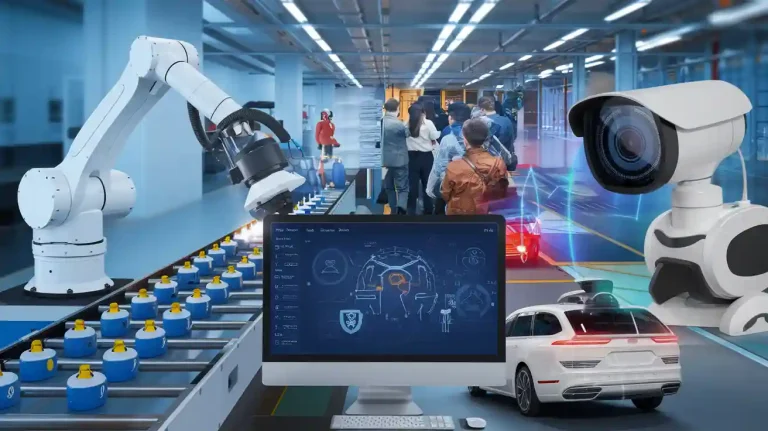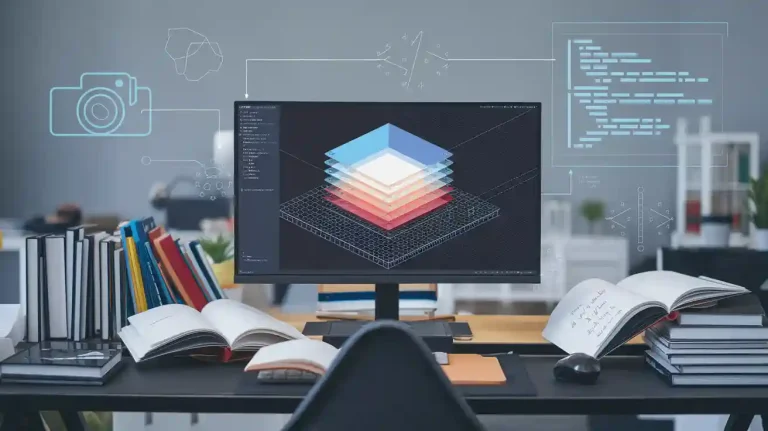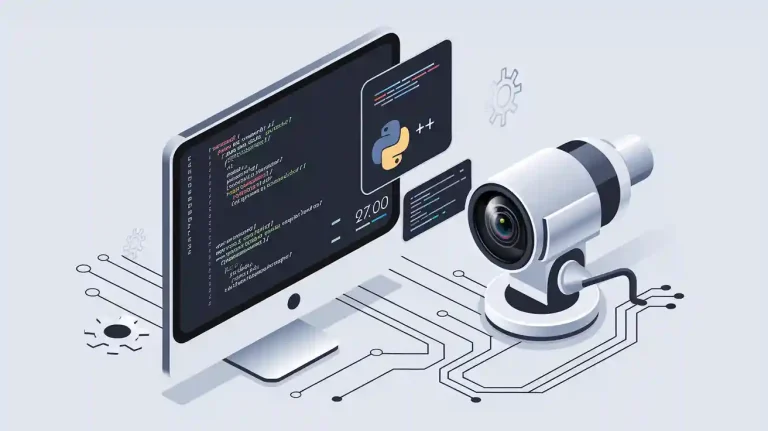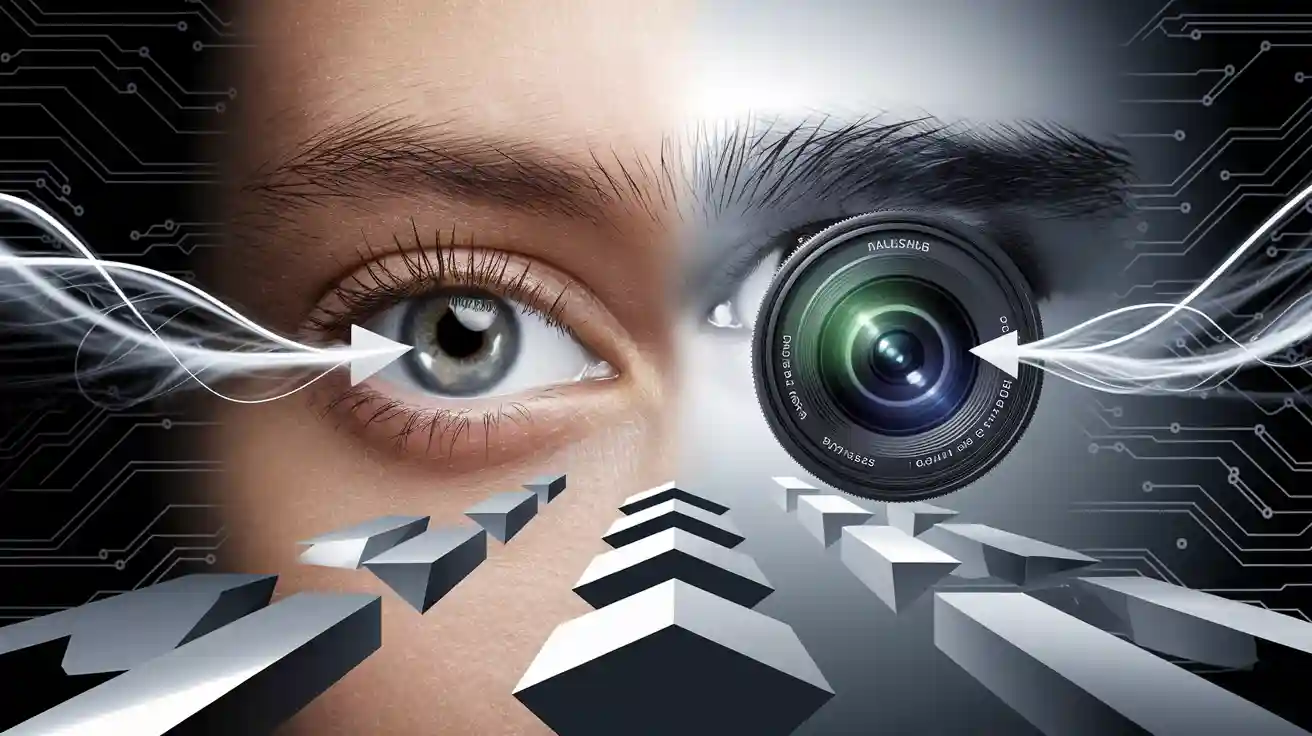
Optical flow transforms how machines see and understand motion. In drone navigation, computer vision systems use optical flow to track pixel movements between image frames, allowing drones to detect objects, avoid obstacles, and adjust routes even in changing weather. These systems rely on motion analysis for real-time decisions, making optical flow essential for safe and reliable operation. Optical Flow machine vision system technology supports real-world applications such as industrial inspection and search-and-rescue, where quick, accurate motion detection matters most. Recent projects show that optical flow enables efficient motion estimation in both human activity recognition and edge devices.
Key Takeaways
- Optical flow helps machines see and understand motion by tracking how pixels move between video frames.
- It powers many applications like robotics, surveillance, autonomous vehicles, and healthcare by enabling accurate object tracking and scene understanding.
- Classic algorithms like Lucas-Kanade and Horn-Schunck estimate motion efficiently, while deep learning models improve accuracy for complex scenes.
- Challenges like limited data, noise, and lighting changes affect performance, but solutions like synthetic datasets and noise-resistant models help overcome them.
- Integrating optical flow with other AI techniques and careful system design boosts reliability and supports real-time, smart machine vision.
Optical Flow Fundamentals
What Is Optical Flow
Optical flow describes how pixels move between two images taken at different times. In computer vision, this concept helps machines understand the direction and speed of objects in a scene. When a camera captures a moving object, the brightness of each pixel usually stays the same from one frame to the next. This idea is called the brightness constancy assumption. By using this rule, engineers can estimate how far and in what direction each pixel has moved.
- Optical flow assigns a two-dimensional motion vector to every pixel. This vector shows both the horizontal and vertical movement.
- The process of calculating optical flow uses the equation: I_x u + I_y v + I_t = 0. Here, I_x and I_y are the changes in brightness across the image, I_t is the change over time, and (u, v) are the motion components.
- The method assumes that motion between frames is small, which allows for easier calculations.
- Optical flow stands out from other motion analysis techniques because it focuses on dense, pixel-level motion estimation. It does not rely on dividing the image into parts or using simple models.
Note: Calculating optical flow depends on the idea that motion is smooth and continuous across the image. This makes it possible to track even small movements.
Why It Matters
Optical flow plays a key role in many machine vision systems. It helps computers understand how objects move and interact in real time. For example, in robotics, calculating optical flow allows robots to avoid obstacles and move safely. In automotive systems, it helps cars detect other vehicles and stay in their lanes. Surveillance cameras use optical flow to monitor crowds and spot unusual behavior. Sports analysts use it to track players and improve performance.
- Optical flow enables accurate motion estimation between frames, which is vital for object tracking and scene understanding.
- It supports applications in film production, where it helps blend computer graphics with real scenes.
- The classical Horn-Schunck method combines data about brightness with smoothness across the image, making optical flow a powerful tool for dense motion analysis.
By calculating optical flow, computer vision systems gain the ability to interpret dynamic scenes, making them smarter and more reliable.
Optical Flow Machine Vision System
Motion Estimation
Motion estimation is a core function of any optical flow machine vision system. This process measures how objects or pixels move between frames in a video. The system calculates dense two-dimensional motion for every pixel, which helps machines understand how things change over time. In real-time applications, optical flow estimation predicts visually-induced motion sickness in 360-degree videos. The system uses pre-processed viewport data to provide smooth, real-time optical flow, even when users move their heads freely. This shows that optical flow can handle dynamic vision tasks without limiting user experience.
Modern optical flow machine vision systems use both traditional and deep learning methods for motion estimation. Early methods solved energy minimization problems but struggled with large or complex movements. Newer deep learning models, such as FlowNet2.0 and PWC-Net, use learned features and layered designs to improve accuracy. These models perform well on benchmarks like Sintel and KITTI, especially for small or fast-moving objects. They also use attention mechanisms and multi-frame strategies to handle occlusions and complex scenes.
Motion estimation is essential in many fields:
- Video surveillance uses it to detect movement and track people.
- Robot navigation relies on it to avoid obstacles and map environments.
- Autonomous vehicles use it to estimate the speed and direction of other cars.
Note: Real-time optical flow estimation also helps with dynamic GPU resource allocation for rendering, making video analysis more efficient.
Object Tracking
Object tracking is another important task for an optical flow machine vision system. The system follows moving objects across video frames by analyzing their motion patterns. Sparse optical flow, combined with machine learning classifiers like Adaboost or SVM, tracks vehicles and pedestrians in real time for surveillance. UAVs use optical flow to detect moving objects and remove background noise, often skipping frames to increase speed. Dense optical flow provides detailed tracking but can be slow on lightweight hardware.
Some improved tracking algorithms use global-local object models and iterative Lucas-Kanade optical flow. These methods filter out noise and boost accuracy. Deep learning models, such as YOLOv3, work with optical flow to detect and track objects from aerial images. This supports real-time tracking in complex environments. Pyramid LK optical flow and corner detection help track objects even when the camera moves or shakes.
Common uses of object tracking in optical flow machine vision systems include:
- Automotive systems, like Tesla Autopilot, use it for collision avoidance and lane tracking.
- Surveillance cameras monitor crowds and spot unusual behavior at large events.
- Sports analytics track player movements to improve performance and reduce injuries.
- Robotics, such as DJI drones, navigate and avoid obstacles without GPS.
- Film and video production use it for motion tracking and scene reconstruction.
- In drone surveillance, optical flow combines with YOLOv5s object detection to improve the accuracy of finding small or moving drones. This method increases average precision by over 11% and keeps real-time speeds above 30 frames per second. The system captures motion information across multiple frames, making it easier to detect dynamic targets.
Scene Understanding
Scene understanding helps an optical flow machine vision system make sense of complex environments. The system analyzes pixel displacement between frames to capture both camera and object motion. It can break down the overall motion into parts: camera movement for static objects and extra movement for dynamic objects. This allows the system to separate moving objects from the background, a process called motion segmentation.
High-quality optical flow enables reliable motion segmentation, even with a stationary camera. The system identifies non-zero flow vectors as moving objects. Advanced deep learning models, such as FlowNet, PWCNet, and RAFT, improve the accuracy and speed of optical flow estimation. This boosts the system’s ability to understand scenes.
Optical flow machine vision systems use scene understanding for:
- Detecting shapes, objects, and motion patterns in video analysis.
- Tasks like 3D reconstruction, motion blur correction, and background replacement.
- Visual effects in movies, such as The Matrix and Mission: Impossible, where the system tracks textures across frames for complex edits.
- Video compression and standards conversion, making video processing more efficient.
| Dataset | Description & Characteristics | Typical Applications & Notes |
|---|---|---|
| Middlebury | Established evaluation methodology; 8 training and 8 test sequences; measures include endpoint and angular error. | Limited complexity and size; not ideal for deep learning or challenging real-time applications. |
| MPI-Sintel | Derived from 3D animated movie; 1064 training and 564 test frames; large motions, occlusions, blur, motion boundaries. | More challenging than Middlebury; less realistic for real-time tasks like autonomous driving. |
| KITTI (2012/15) | Real-world driving scenarios; tailored for autonomous driving applications. | Widely used for evaluating optical flow in self-driving and robotics contexts. |
| Flying Chairs & ChairsSDHom | Large synthetic datasets with ground truth; designed for training deep CNNs; data augmentation applied. | Used primarily for supervised training of deep learning models. |
| CrowdFlow | Synthetic dataset simulating crowded pedestrian scenes; includes temporal consistency evaluation. | Useful for crowd movement analysis and tracking in dense scenes. |
| FlyingThings3D | Large-scale synthetic dataset with diverse 3D object motions; dense accurate ground truth. | Suitable for training and benchmarking with complex 3D motion scenarios. |
| Monkaa | Derived from animated short film; features non-rigid motion and camera changes. | Similar to MPI-Sintel; useful for non-rigid motion estimation. |
| Driving | Synthetic driving scenes similar to KITTI; includes car models and street elements. | Focused on dynamic driving applications. |
| Creative Flow+ | Multi-style artistic video dataset with non-photorealistic and stylized content; high resolution. | Enables evaluation of optical flow on stylized and artistic imagery, expanding research scope. |
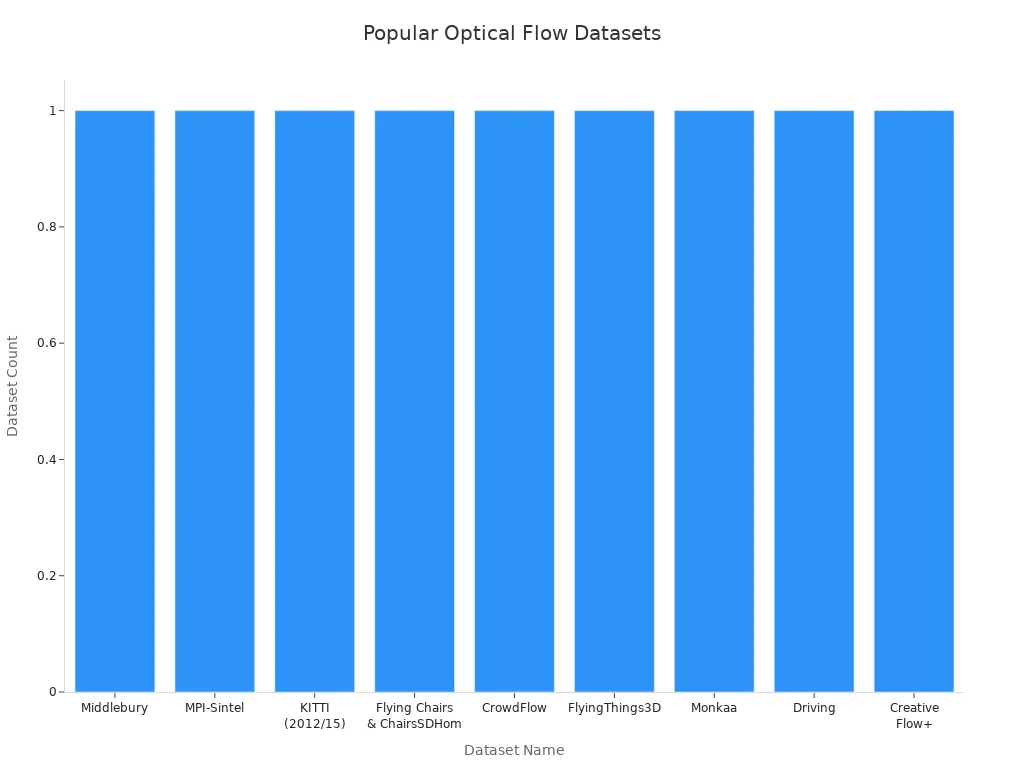
Tip: Using the right dataset helps researchers test and improve optical flow machine vision systems for different real-world tasks.
Key Algorithms
Lucas-Kanade
The Lucas-Kanade algorithm stands as a classic method for estimating optical flow. This approach uses the Brightness Constancy Principle, which means the brightness of a pixel stays the same as it moves. The algorithm assumes that all pixels in a small area move together with the same speed and direction. This idea helps solve the optical flow constraint equation using a least squares method. The table below explains the core principles:
| Core Principle | Explanation |
|---|---|
| Brightness Constancy Assumption | The brightness of a pixel remains constant over time despite movement. |
| Optical Flow Constraint Equation | Ix * vx + Iy * vy + It = 0, where Ix, Iy, It are image derivatives, and (vx, vy) is velocity. |
| Aperture Problem | One equation with two unknowns; cannot be solved uniquely for a single pixel. |
| Lucas-Kanade Assumption | All pixels within a small neighborhood share the same velocity. |
| Solution Method | Least squares approach estimates the optical flow vector. |
| Handling Large Motions | Uses a pyramidal approach, starting with low-resolution images and refining results. |
| Iterative Refinement | Updates improve accuracy until the solution converges. |
Lucas-Kanade works well for small, steady movements. It is fast and easy to use, making it popular in real-time systems. However, it struggles with rapid motion, changes in brightness, or when objects move in different directions within the same area.
Horn-Schunck
The Horn-Schunck algorithm takes a different approach to optical flow estimation. It uses an energy minimization method that combines two main ideas: brightness constancy and smoothness. The algorithm calculates flow for every pixel by minimizing a function that balances how well the flow matches the image data and how smooth the flow field is across the image. The method uses image gradients and a regularization parameter to control smoothness. Iterative updates refine the flow vectors until the solution stabilizes. Horn-Schunck produces dense flow fields and works well for parallel processing. It is useful for tracking objects and analyzing motion in videos. However, it can struggle with large movements or when objects become hidden.
Deep Learning Methods
Recent advances in deep learning have changed how computers estimate optical flow. Models like FlowNet, PWC-Net, and RAFT use convolutional neural networks to learn motion patterns from large datasets. These methods do not rely on handcrafted features or fixed equations. Instead, they learn directly from examples. Deep learning models often use ideas from traditional algorithms, such as pyramidal processing and warping, to improve accuracy and speed. They achieve high performance on public benchmarks but need powerful GPUs for training and testing. Challenges include a lack of real-world labeled data and differences between synthetic and real scenes. Researchers use metrics like Endpoint Error (EPE) and cosine similarity to measure accuracy and robustness.
Tip: Deep learning models for optical flow continue to improve, making them suitable for complex tasks in robotics, surveillance, and video analysis.
Applications
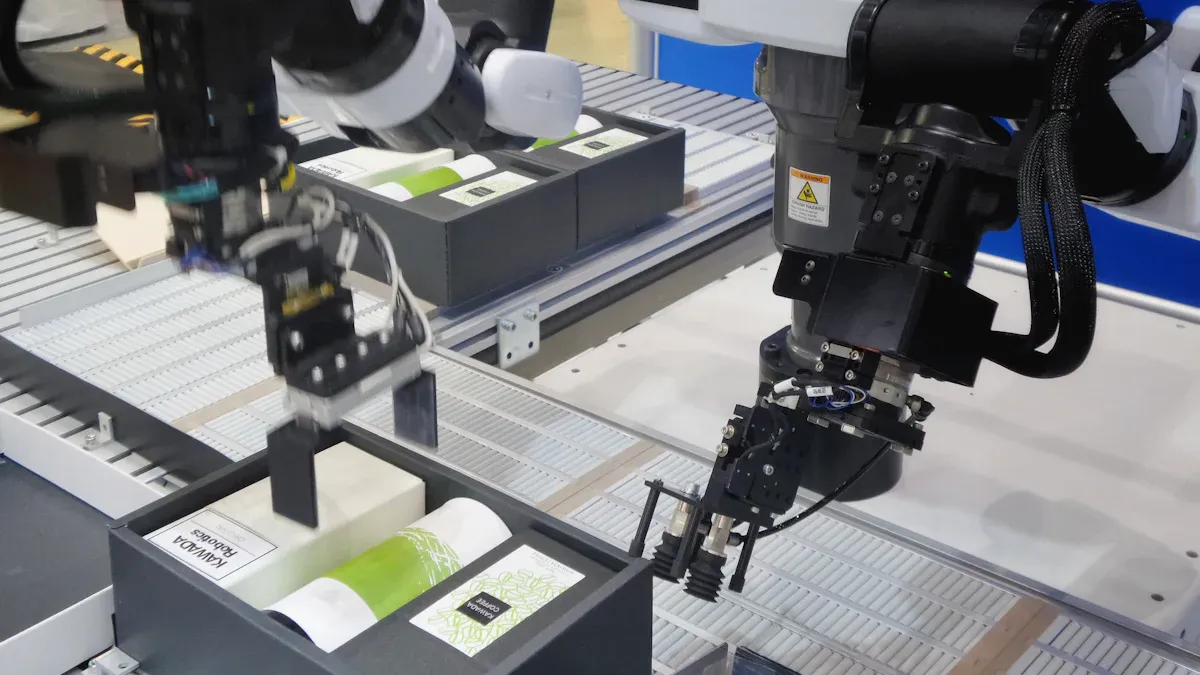
Robotics
Robotics uses optical flow for many important applications. Robots use optical flow to sense movement and avoid obstacles. Bioinspired feedback control loops help robots navigate indoor spaces. Some robots use optic-flow-based autopilots for collision avoidance. Neuromorphic event-based vision systems give robots fast and accurate sensing. These systems work well for real-time robotic control. Hierarchical spiking neural networks process event-based optical flow, which helps robots understand global motion. Insect-like walking robots and autonomous vehicles show how optical flow supports safe navigation and obstacle avoidance.
| Aspect | Description |
|---|---|
| Applications in Robotics | Obstacle avoidance, navigation, object manipulation, and human-robot interaction. |
| Case Studies | Use in object tracking, 3D reconstruction, and trajectory planning. |
| Challenges | Real-time processing demands, sensor noise, occlusion, and large displacements affect accuracy. |
| Solutions | Robust algorithms (e.g., Horn-Schunck), deep learning approaches, sensor fusion techniques. |
| Effectiveness | Demonstrated in bioinspired control loops for collision avoidance and neuromorphic vision systems. |
Surveillance
Surveillance systems rely on optical flow to improve motion detection and tracking in video feeds. Many modern frameworks combine optical flow data with deep learning and adaptive thresholding. This approach increases motion segmentation accuracy. Optical flow helps track objects over time, even when they become hidden or look similar to others. Systems using optical flow show better performance on benchmark datasets like MOT17 and KITTI. Some advanced tracking methods use motion cues from optical flow with deep learning models. This combination helps track multiple objects in crowded scenes. Studies show that optical flow-based motion segmentation leads to more reliable tracking in surveillance video. The use of recurrent neural networks and adaptive graph fusion with optical flow further improves accuracy and consistency.
- Adaptive Optical Flow Segmentation (OFATS) enhances motion detection in video.
- Optical flow improves temporal consistency in object tracking.
- Methods using optical flow outperform older approaches on datasets like MOT challenge and KITTI.
- Combining optical flow with deep learning boosts tracking in crowded or complex video scenes.
Industrial Automation
Industrial automation benefits from optical flow in many ways. Machines use optical flow to monitor conveyor belts and detect faulty products. Automated inspection systems analyze video streams to spot defects in real time. Optical flow helps robotic arms track moving parts and adjust their actions. This technology supports quality control by finding changes in product appearance. Factories use optical flow to guide robots and vehicles safely through busy environments. These applications make production lines faster and more reliable.
Healthcare
Healthcare uses optical flow to analyze movement in medical video. Doctors use it to study blood flow in ultrasound videos. Optical flow helps track the motion of organs during surgery. It supports patient monitoring by analyzing body movements in rehabilitation sessions. Researchers use optical flow to detect changes in heart or lung motion in video data. These applications help doctors make better decisions and improve patient care.
Challenges and Solutions
Data Limitations
Optical flow systems often face several data-related challenges that impact their performance:
- Limited dataset size and diversity restrict model generalization to new environments.
- Differences in sensor types between training and deployment create a domain gap, making feature extraction less effective.
- Datasets may lack variety in content, causing poor results in underrepresented scenarios.
- Rare but important situations, called corner cases, are often missing, reducing system reliability.
- Accurate ground truth data for optical flow is hard to obtain and time-consuming to create.
- Many datasets do not include enough examples of difficult conditions like fog, rain, or reflections.
- Synthetic datasets, while helpful, sometimes lack the realism needed for real-world applications.
These issues can lower accuracy and make systems less robust. To address the lack of labeled data, researchers use synthetic datasets such as Flying Chairs, FlyingThings3D, and Monkaa. These datasets allow for pre-training models, which are then fine-tuned on smaller real-world datasets. Some teams use self-training frameworks that generate new training data without manual labeling, reducing the need for human effort.
Noise and Lighting
Noise and lighting changes present major obstacles for optical flow estimation. Low-light conditions introduce imaging noise, which reduces accuracy and makes it harder to separate moving objects from the background. Researchers have developed noise-resistant networks and multi-level noise modeling to improve performance in these situations. These methods help systems maintain precision even when lighting is poor or noise levels are high.
Tip: Training with noisy and low-light data can make optical flow models more robust in real-world environments.
Integration Tips
Integrating optical flow into machine vision pipelines requires careful planning. Here are some practical tips:
- Set up a Python environment with libraries like OpenCV and NumPy.
- Preprocess images by resizing and normalizing them, and use data augmentation to improve robustness.
- Align image frames in time to ensure accurate motion analysis.
- Use classical algorithms like Lucas-Kanade for sparse flow or Farnebäck for dense flow.
- Handle occlusions and large movements with multi-scale approaches and robust loss functions.
- Combine optical flow with object detection, tracking, or deep learning to enhance system capabilities.
| Challenge | Practical Solution |
|---|---|
| Scarcity of labeled datasets | Use synthetic data and domain adaptation techniques |
| Domain gap between synthetic and real data | Apply style transfer and semi-supervised learning |
| Noise in unsupervised learning targets | Integrate supervised architectures into unsupervised frameworks |
| Dynamic environments and occlusion | Use AI-powered adaptive algorithms and advanced segmentation methods |
Note: Combining optical flow with other AI techniques helps systems adapt to changing environments and improves overall reliability.
Optical flow gives machine vision systems the power to understand motion at the pixel level. This technology supports action recognition, object tracking, and video processing in many industries. Recent deep learning models, like RAFT, improve accuracy but still face challenges such as error propagation and handling difficult scenes. Experts see a future with higher resolution cameras, better optics, and more advanced computing. New applications in autonomous vehicles, medical imaging, and logistics will continue to grow. Machine vision will need flexible hardware and smarter software to keep up with these changes.
FAQ
What is the main purpose of optical flow in machine vision?
Optical flow helps machines see how objects move in a scene. It lets systems track motion, follow objects, and understand changes between video frames. This makes robots, cameras, and vehicles smarter and safer.
How does optical flow improve object tracking?
Optical flow gives each pixel a motion direction. Systems use this data to follow moving objects, even when they change speed or direction. This helps cameras and robots keep track of people, cars, or animals in real time.
Which industries use optical flow technology?
- Robotics
- Automotive
- Surveillance
- Healthcare
- Industrial automation
Many industries use optical flow to boost safety, quality, and efficiency.
Can optical flow work in low-light or noisy environments?
Optical flow can struggle with noise or poor lighting. Newer models use noise-resistant networks and special training data. These improvements help systems work better in tough conditions.
What are some popular optical flow algorithms?
| Algorithm | Key Feature |
|---|---|
| Lucas-Kanade | Fast, good for small motion |
| Horn-Schunck | Dense flow, smooth results |
| RAFT | Deep learning, high accuracy |
Each algorithm fits different needs and hardware.
See Also
How Optical Filters Enhance Performance In Machine Vision
Comparing Firmware-Based And Traditional Machine Vision Systems
Understanding Pixel-Based Machine Vision In Today’s Applications







